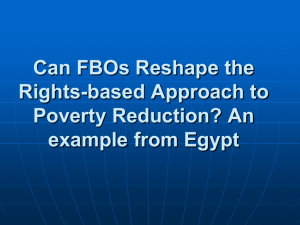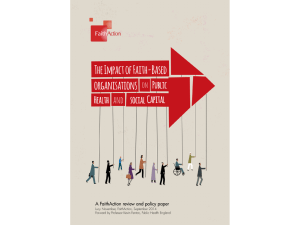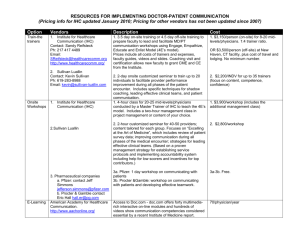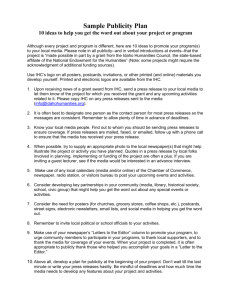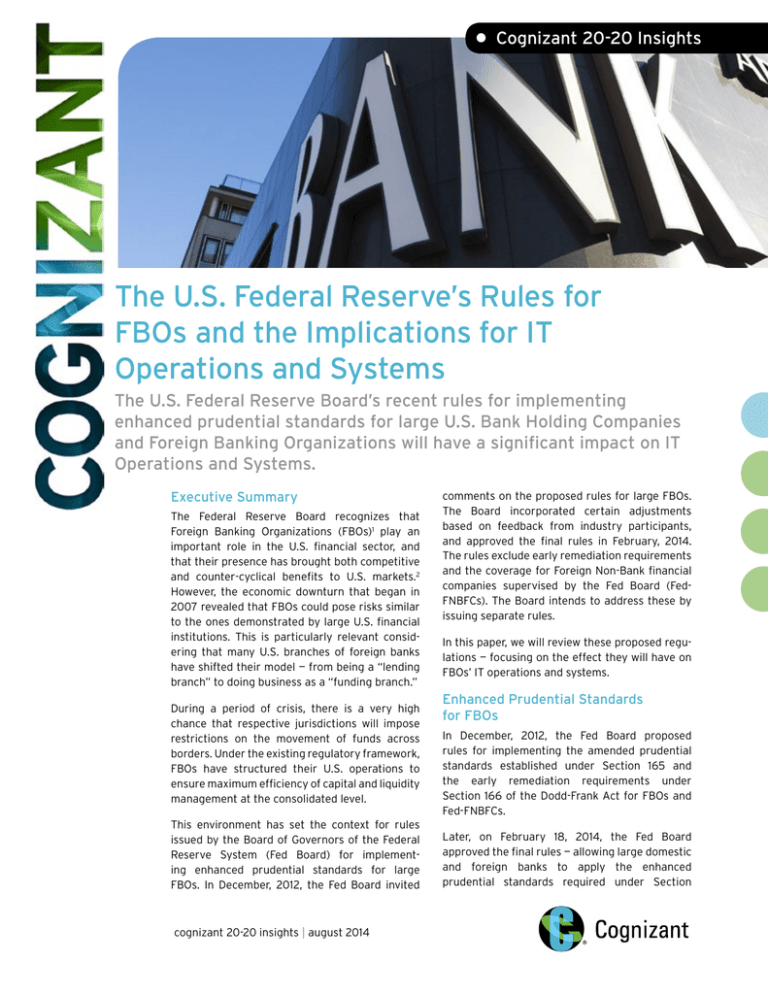
• Cognizant 20-20 Insights
The U.S. Federal Reserve’s Rules for
FBOs and the Implications for IT
Operations and Systems
The U.S. Federal Reserve Board’s recent rules for implementing
enhanced prudential standards for large U.S. Bank Holding Companies
and Foreign Banking Organizations will have a significant impact on IT
Operations and Systems.
Executive Summary
The Federal Reserve Board recognizes that
Foreign Banking Organizations (FBOs)1 play an
important role in the U.S. financial sector, and
that their presence has brought both competitive
and counter-cyclical benefits to U.S. markets.2
However, the economic downturn that began in
2007 revealed that FBOs could pose risks similar
to the ones demonstrated by large U.S. financial
institutions. This is particularly relevant considering that many U.S. branches of foreign banks
have shifted their model — from being a “lending
branch” to doing business as a “funding branch.”
During a period of crisis, there is a very high
chance that respective jurisdictions will impose
restrictions on the movement of funds across
borders. Under the existing regulatory framework,
FBOs have structured their U.S. operations to
ensure maximum efficiency of capital and liquidity
management at the consolidated level.
This environment has set the context for rules
issued by the Board of Governors of the Federal
Reserve System (Fed Board) for implementing enhanced prudential standards for large
FBOs. In December, 2012, the Fed Board invited
cognizant 20-20 insights | august 2014
comments on the proposed rules for large FBOs.
The Board incorporated certain adjustments
based on feedback from industry participants,
and approved the final rules in February, 2014.
The rules exclude early remediation requirements
and the coverage for Foreign Non-Bank financial
companies supervised by the Fed Board (FedFNBFCs). The Board intends to address these by
issuing separate rules.
In this paper, we will review these proposed regulations — focusing on the effect they will have on
FBOs’ IT operations and systems.
Enhanced Prudential Standards
for FBOs
In December, 2012, the Fed Board proposed
rules for implementing the amended prudential
standards established under Section 165 and
the early remediation requirements under
Section 166 of the Dodd-Frank Act for FBOs and
Fed-FNBFCs.
Later, on February 18, 2014, the Fed Board
approved the final rules — allowing large domestic
and foreign banks to apply the enhanced
prudential standards required under Section
165 of the Dodd-Frank Wall Street Reform and
Consumer Protection Act (Dodd-Frank Act).
These rulings incorporated certain adjustments
based on the comments received from various
industry and market participants.
For a large FBO with total conStructural solidated assets of US$50
billion or more, the rules
diversity, along cover enhanced leverage and
with consolidated risk-based capital requiremanagement of ments; requirements related to
liquidity, risk-management and
capital and liquidity, stress-testing; as well as a debthas facilitated cross- to-equity limit for companies
border banking and that the Financial Stability
Oversight Council (FSOC) has
increased global determined pose a grave threat
flows of capital to the financial stability of the
and liquidity. U.S. The prudential standards
exclude the earlier proposed
guidelines for single counterparty credit limits and the early remediation
requirements. They do not impose the amended
prudential standards on Fed-FNBFCs.
The rules also establish a risk-committee requirement for publicly traded FBOs with total consolidated assets of US$10 billion or more, as well as
stress-testing stipulations for FBOs and foreign
savings and loan holding companies with total
consolidated assets3 of US$10 billion or more.
Additionally, the rulings mandate that every FBO
with U.S. non-branch assets of US$50 billion or
more form a U.S. Intermediate Holding Company
(IHC), which would serve as a U.S. top-tier bank
holding company for its U.S. subsidiaries.
Factors Leading to Enhanced
Prudential Standards
The profile of FBOs’ operations in the U.S.
changed substantially in the period preceding
the financial crisis. U.S. branches and agencies
of FBOs went from receiving funding from their
parent organizations on a net basis in 1999, to
providing significant funding to non-U.S. affiliates
by the mid-2000s. In 2008, these U.S. branches
and agencies provided more than US$600 billion
cognizant 20-20 insights
on a net basis to non-U.S. affiliates. Since the U.S.
operations of FBOs received less funding (on net
terms) from their parent companies over the past
decade, they became more reliant on less stable,
short-term U.S. dollar wholesale funding — contributing in some cases to a buildup in maturity
mismatches.4 This structural diversity, along
with consolidated management of capital and
liquidity, has facilitated cross-border banking and
increased global flows of capital and liquidity.
The growth in concentration, complexity and
interconnectedness of FBOs’ U.S. operations and
the lessons learned during the crisis have raised
concerns about the stability of the U.S. banking
system, since many branches of the FBOs have
shifted from being “lending branches” to “funding
branches” of foreign banks.
More importantly, the Congressional mandate
included in the Dodd-Frank Act requires the Fed
Board to impose amended prudential standards
on large FBOs. Congress also directed the Fed
Board to strengthen the capital standards applied
to U.S. Bank Holding Company (USBHC) subsidiaries of FBOs by adopting the so-called ‘‘Collins
Amendment’’ to the Dodd-Frank Act. Specifically, Section 171 of the Dodd-Frank Act requires
a top-tier USBHC subsidiary of an FBO that had
relied on Supervision and Regulation Letter 01-01
to meet the minimum capital requirements established for USBHCs by July 21, 2015.5
The Impact on FBOs
FBOs with total consolidated assets of US$50
billion or more fall under the general scope of
these rules. Risk-committee and stress-testing
standards will apply to a larger group of FBOs
(total assets of US$10 billion or more). The latter
is also applicable to foreign savings and loanholding companies. Additionally, FBOs with U.S.
non-branch assets of US$50 billion or more
would be required to form a U.S. IHC that would
be directly subject to the enhanced prudential
standards. Figure 1 provides a summary of the
rules that would apply to the FBOs.
2
Scope of Application of Rules for FBOs
Global Assets
U.S. Assets
Summary of Requirements
More than US$10 billion
but less than US$50
billion.
-
n
Company-Run Stress Tests.
More than US$10 billion
but less than US$50
billion. +Publicly traded.
-
n
Risk Committee Requirements.
More than US$50 billion.
Less than US$50
billion.
n
Risk-based and leverage capital requirements.
Risk management requirements.
Risk committee requirements.
Liquidity standards.
Capital stress-testing requirements.
Debt-to-equity limits (upon determination by FSOC).
n
n
n
n
n
More than US$50 billion.
More than US$50
billion.
n
n
n
n
n
n
n
n
Risk-based and leverage capital requirements.
Risk management requirements.
Risk committee requirements.
Liquidity standards.
Liquidity stress-testing requirements.
Capital stress-testing requirements.
Debt-to-equity limits (upon determination of grave threat).
U.S. IHC requirement (if the FBO has U.S.
non-branch assets of US$50 billion or more).
Source: p17245 Federal Register/ Vol. 79, No. 59 / Thursday, March 27, 2014 / Rules and Regulations, 12 CFR Part 252
(http://www.gpo.gov/fdsys/pkg/FR-2014-03-27/pdf/2014-05699.pdf)
Figure 1
Review of Proposed Regulations
assets of US$250 billion or more, or total consolidated on-balance sheet foreign exposures
of US$10 billion or more — the minimum supplementary leverage ratio of 3%.
• Formation of U.S. IHC: FBOs with total con-
solidated assets of US$50 billion or more
and with combined U.S. non-branch assets of
US$50 billion or more would be required to
establish a top-tier U.S. IHC (in exceptional
circumstances, multiple U.S. IHCs) to hold all
U.S. bank and non-bank subsidiaries of the
company, except for any company held under
Section 2(h) (2)6 of the Bank Holding Company
Act. The U.S. non-branch assets include all consolidated on-balance-sheet assets (other than
assets held by a Section 2(h) (2) company or by
a DPC branch subsidiary).7
• Capital requirements (risk-based and lever-
A U.S. IHC would be required to make public
capital disclosures unless the FBO is subject to
comparable public disclosure requirements in
its home jurisdiction. Further, a U.S. IHC would
have to submit an annual capital plan to the
Federal Reserve. An FBO would have to certify
that the capital adequacy standards at the consolidated (parent) level are consistent with the
Basel Capital Framework.
• Liquidity
requirements: This rule requires
that an FBO with combined U.S. assets of
US$50 billion or more establish a framework
for managing liquidity risk, engaging in independent review and making cash-flow projections. The FBO should also establish a contingency funding plan and specific limits; monitor
and stress-test its combined U.S. operations as
well as its U.S. IHC and its U.S. branches and
agencies (if any); and hold certain liquidity
buffers.8 For liquidity requirements, combined
age): These would be regulated at the U.S. IHC
level and be similar to those applicable for U.S.
BHCs. However, the U.S. IHCs will be exempt
from the advanced approach rules of the U.S.
Hence, capital adequacy will be addressed by
standardized risk-based capital rules, as well as
capital-planning and supervisory stress-testing
requirements. Leverage capital requirements
include the generally applicable leverage ratio
of 4% for U.S. IHCs with total consolidated
cognizant 20-20 insights
3
U.S. assets are required to be computed as
“Total combined assets of U.S. operations, net
of intercompany balances and transactions
between U.S. domiciled affiliates, branches
and agencies.”
• Stress
testing: This rule requires the FBO
parent of a U.S. IHC to undergo a homecountry stress-testing regime and to report
the results to the Fed Board. A U.S. IHC must
project its regulatory capital ratios in its
stress tests without additional consideration
of possible support from its home-country
parent. It would be subject to reporting obligations in connection with its company-run
and supervisory stress tests, and would be
required to publicly disclose the results of
the company-run stress tests. In addition to a
U.S. IHC, an FBO with combined U.S. assets of
US$50 billion or more would have to submit
key information regarding the results of its
home-country stress tests. If an FBO doesn’t
meet the stress-testing standards, the Board
would mandate that its U.S. branches and
agencies, as applicable, maintain eligible assets
equal to 108% (105% if combined U.S. assets
are more than US$10 billion but less than
US$50 billion) of third-party liabilities,
calculated on an aggregate basis. FBOs with
total consolidated assets of more than US$10
billion but less than US$50 billion, and foreign
savings and loan-holding companies with total
consolidated assets of more than US$10 billion,
are allowed to use home-country stress tests.
The rule limits concentrations of funding by
instrument type, single counterparty, counterparty type, secured and
FBOs that meet or unsecured funding, and other
liquidity risk identifiers; the
exceed the asset amount of specified liabilities
threshold on July 1, that mature within various
2015 would be time horizons; and off-balancesheet and other exposures that
required to meet could create funding needs
the new standards during liquidity stress events.9
(including the U.S. The rule contains an internal
monitoring requirement, which
IHC requirement) by stipulates that FBOs establish
July 1, 2016. and maintain procedures for
monitoring intra-day liquidity
risk of their U.S. operations. However, it does
not require global cash-flow statements for
activities conducted in U.S. dollars. The Fed
Board will subsequently implement the quantitative liquidity standards included in Basel III
(LCR, NSFR) through separate rulemakings.
The liquidity stress-testing requirements
mandate that the stress test be conducted
at both the combined U.S. operations level
and separately for U.S. IHC and U.S. branches
and agencies of FBOs. Stress scenarios must
also use a minimum of four time horizons,
including overnight, 30-day, 90-day and one
year. FBOs are expected to use their company-specific internal models for stress-testing
requirements.
The rule requires a U.S. IHC to maintain a
buffer of unencumbered, highly liquid assets to
offset net stressed cash outflows for the first
30 days in the U.S. The FBO’s U.S. branches and
agencies would have to maintain a separate
buffer for only the first 14 days in the U.S. While
highly liquid assets predominantly include cash
and securities issued or guaranteed by the U.S.
government, a U.S. government agency or a
U.S. government-sponsored enterprise, the
rule allows other types of assets, provided the
FBO is able to justify to the Federal Reserve
that it has low credit and market risk, is actively
traded in secondary markets, and was historically purchased by investors during periods of
liquidity stress.
cognizant 20-20 insights
• Risk management: An FBO with any class of
publicly traded stock and total consolidated
assets of US$10 billion or more, and any FBO
(regardless of whether its stock is publicly
traded) with total consolidated assets of
US$50 billion or more would be required to
certify that it maintains a U.S. risk committee
on its board of directors or equivalent homecountry governance structure.10 This provides
a certain degree of flexibility for FBOs to
establish their U.S. risk committee — as either a
committee of their home offices or of U.S. IHCs.
In addition, FBOs with combined U.S. assets
of US$50 billion or more would be required
to adhere to additional risk-management
rules, such as appointing a U.S. Chief Risk
Officer and an independent member in the U.S.
risk committee.
Once the Financial Stability Oversight Council
determines that an FBO poses a “grave threat” to
U.S. financial stability, the Fed requires the FBO to
limit its debt-to-equity ratio to 15-to-1 on its U.S.
IHC and any U.S. subsidiary not organized under
a U.S. IHC (other than a Section 2(h)(2) company).
It also mandates 108% asset maintenance on its
U.S. branches and agencies as an equivalent to a
4
debt-to-equity limitation. The rules don’t impose
a cap on cross-border intra-group flows, thereby
allowing FBOs in sound financial condition to
continue to obtain U.S. dollar funding for their
global operations through their U.S. operations.
Getting There
The Fed Board is proposing a substantial phase-in
period to give FBOs time to adjust to the new
rules. FBOs that meet or exceed the asset
threshold on July 1, 2015 will be required to meet
the new standards (including the U.S. IHC requirement) by July 1, 2016 (extended by a year due to
concerns raised during the comment period). For
FBOs that meet the criteria after July 1, 2015, the
rules require compliance beginning the first day
of the ninth quarter (effective compliance period
of two years) after the FBO meets or exceeds the
threshold.
By July 1, 2016, a U.S. IHC must hold its FBO’s
ownership interest in any U.S. BHC subsidiary and
any depository institution subsidiary, as well as in
U.S. subsidiaries representing 90% of the FBO’s
assets not held by the bank holding company or
depository institution. The rule gives an FBO until
July 1, 2017, to transfer its ownership interest in
any residual U.S. subsidiaries to the U.S. IHC.
their presence in the U.S., since they are likely to
see an increase in compliance costs. Some of the
key areas that will impact the business strategy
and operations are:
• Governance:
Firms may need to establish a
separate board of directors (or equivalent),
a Chief Risk Officer and additional risk
committees to demonstrate the autonomy and
accountability of the U.S. IHC to the regulators.
To conform to these requirements, firms may
have to undergo organizational restructuring
and consolidation of business entities across
lines of business (such as asset management,
capital markets, insurance, etc.).
• Cost of operations: Financial institutions may
experience an increase in operational costs
as they build their ability to operate independently at the U.S. IHC level (like restructuring
operations to transfer subsidiaries to the U.S.
IHC, revising trade-related and employment
contracts, reallocating assets, etc.). They will
also need to make additional investments in
their technology infrastructure to support the
new governance, reporting and compliance
requirements. Tax costs, if any, would be over
and above these expenditures.
• Risk
policy: Financial institutions will be
required to hold additional capital and liquidity
buffers at the U.S. IHC level, resulting in an
increase in the cost of capital. Moreover,
the liquidity buffer should include HQLA as
defined by the U.S. Fed, which at the moment
only includes instruments issued by the U.S.
government or government-backed entities.
Other factors, such as building contingency
plans in case intra-group funding dries up,
might further drive up costs. These additional
expenditures will be a negative factor on the
return on equity for investments in the U.S.
A U.S. IHC formed by July 1, 2016 will be required
to submit its first capital plan by January 2017.
Consistent with the Basel III transition period, the
rule delays application of the generally-applicable
leverage ratio to U.S. IHCs until January 1, 2018.
The debt-to-equity ratio limitation would be in
effect on the effective date of the final rule.
Impact of the Regulations
The approved rules have significant and wideranging implications for foreign banks and
financial institutions:
Business Strategy and Operational Impact
The Impact on IT Operations and Systems
The FBO regulation will be a key driver for the
business strategies of the FBOs in the U.S.
Most institutions will probably choose to grow
cautiously, while others may decide to reduce
Any impact on business strategy and operations
will have an impact on the bank’s associated
technology operations. Figure 2 provides a review
of the key IT focus areas.
cognizant 20-20 insights
5
IT Impact of FBO Regulations
IT Group
Impact
Applicable Guideline
Operational
and Reference
Data
Build the ability to integrate and monitor financial information at the U.S. IHC level. This may require firms to review
their legal entities and account hierarchy relationships
across various business lines.
Formation of a U.S. IHC
Develop additional reporting capabilities for large organizations to comply with BIS and FSOC SIB (Systemically
Important Banks) regulations and various additional reports
related to structural changes, country exposure reports, consolidated reports, etc.
Formation of a U.S. IHC
Integrate limits-monitoring systems across business lines to
help ensure the ability to aggregate information — monitor,
assess and report concentrations in sources of liquidity risk,
maturity time horizons of liabilities, and on-and off-balance
sheet exposures, etc.
Liquidity Requirements.
Assess and enhance systems to aggregate and monitor the
risk at the U.S. IHC level. This would involve ensuring the
ability to slice-and-dice data against key parameters such as
books, regions, legal entities, business lines, currencies, etc.,
as well as configure the systems to accept multiple values of
key inputs (like surcharges, buffers, haircuts, projected cash
flows, valuations, discount factors, shocks, etc.).
Formation of a U.S. IHC
Build a centralized collateral-management system with the
ability to assign and lock the collateral at the U.S. IHC level
to maintain separate liquidity buffers globally and at U.S.
IHCs. This requires streamlining the systems across various
businesses to help ensure consistency in the information
attributed to various assets, such as location of the asset,
netting agreements, gross vs. net recordings (applicable
netting rules might be different), maturity computations
(trade date basis vs. settlement date basis, day count
convention, actual vs. effective maturity, etc.).
Liquidity Requirements
Improve system capabilities to apply various models (e.g.,
foundational and advanced approaches for capital computation) on subsets of operational data, and account for differences in the Basel implementation guidelines in the home
country (parent/group level) and in the U.S.
Capital Requirements
Assess the impact of the recently finalized U.S. Basel III
liquidity requirements on the current liquidity reporting
infrastructure and its ability to project liquidity cash flows
and report liquidity metrics (LCR, NSFR) for the U.S. IHC,
including generating liquidity stress reports. For example,
equity exposures have a granular assignment of risk weights
in the Fed’s U.S. Basel III compared to OSFI guidelines.
Liquidity Requirements
Analytics
and Reporting
Risk
Technology
Gauge the ability to globally generate regulatory and stress
scenario results; the U.S. IHC systems might require enhancements to accept and act on the inputs from regulators for
supervisory stress-testing.
This would require the ability to aggregate and report risk
sensitivities, scenarios and P&L results by the U.S. IHC. legal
entity framework.
Figure 2
cognizant 20-20 insights
6
Stress-Testing Guidelines
Lines of Business Impacted by FBO Regulations
Advisory/M&A
Product Control
P&L Analysis,
Reporting
Reconciliation
(Nostro/Depot/GL)
Ledger Control
& Reporting
IB Finance
Financial
Accounting
& Reporting
Billing &
Invoicing
General Ledger
Postings
Front Office
Client
Connectivity
Telephone/Fax/
Email/FIX
Exchange/
ECN Connectivity
Other Channels
Vendor/Partner
Connectivity
Clearing & Settlement
Securities
Reference Data
Clearance & Settlement
Position Management
Fails Management
Payment Processing
Middle Office
Back Office
Sales &
Marketing
Management
Securities
Lending
Collateral
Management
Corporate
Actions
Safekeeping
& Custody
Proxy
Management
Risk Management
Market Risk
Counterparty/
Credit Risk
AML/KYC
Processing
Trade
Surveillance
Liquidity Risk
Limits
Management
Regulatory
Reporting
Legal
Risk Monitoring,
Analysis &
Reporting
Enterprise/
Operational Risk
Client
Reference Data
Trade Data
Market Data
Instructions
(SSI) Data
Order
Management
Pricing &
Structuring
Quoting/
Market Making
Advanced
Execution
Pre/Post Trade
Analytics
Pre-Trade
Compliance
Trade Management
Trade Capture
& Enrichment
Transaction
Figuration
Matching
& Netting
Allocation
& Booking
Confirmation
& Affirmation
PositionKeeping
Trade &
Transaction
Reporting
Give Up
Processing
Account Data
Book Data
Functions Impacted
Figure 3
Figure 3 provides a high-level view of the functions
that are impacted by the Fed Board’s enhanced
prudential standards for FBOs.
Looking Ahead: Increasing Mandates
So far, regulation of foreign banks in the U.S. has
been performed on an ad-hoc, or “case-by-case”
basis. After a decade of inaction, the approved
FBO rules represent sweeping changes, and
are thought to be consistent with the Federal
Reserve’s longstanding policy of national
treatment and equality of competitive opportunity between the U.S. operations of FBOs and U.S.
banking firms.
While critics of these guidelines argue that the
U.S. did not experience a destabilizing failure of
FBOs during the global financial crisis, preventive actions are nonetheless needed, especially
given today’s global economic scenario. Clearly,
the proposed regulations would help ensure the
3Cs — consistent, consolidated and comprehensive application of the rules for FBOs operating
in the U.S. This would place all banks operating in
cognizant 20-20 insights
the U.S. on an equal footing. Of course, the logical
fallout could lead regulators in other countries
to follow suit by making cross-border operations
more complex and costly. Furthermore, critics
argue that regulatory consistency among parent
and host countries would be lost if these regulations are implemented.
A U.S. IHC structure would create a platform
for consistent supervision and regulation of
U.S. operations of FBOs, and help facilitate the
resolution of failing U.S. operations of a foreign
bank if needed. Certain industry participants
questioned the authority, appropriateness and
necessity of this onerous prudential standard.
The Board justified it by citing consistency of
regulation across U.S. non-branch operations of
FBOs and the assurance of a level playing field
for FBOs and U.S. BHCs. The Fed Board further
expressed that any additional cost concerns
would be addressed by the financial-stability
benefits to the institution.
We believe that the proposed capital and leverage
requirements will help bolster the consolidated
7
Product
Management
Order Management & Trading
Income & Dividend Processing
Legal &
Compliance
Pricing Data
Business Development
Asset Servicing
Management/
Control Reporting
Accounts
Payable/
Receivables
Data
Management
Services
Interfaces
Reconciliation (FOBO/BOBO)
Accounting, Controlling and Reporting
Funds Transfer
Cost Attribution
Core Processing Services
Research
Treasury
Cash Management
& Forecasting
CRM
Channels
Client/Partner/
Trading Portals
Margin
Execution Services
Advisory
Client Inquiries
Communication Services
Securitized
Products
Client On
Boarding
Valuations & Reporting
IPO &
Underwriting
Client Services
Client Management
Syndication &
Leveraged Finance
Risk & Compliance
Investment Banking
Financing
Structured
Finance
capital positions of the U.S. IHCs and promote
equal footing for all banks operating in the United
States. The liquidity requirements will help make
the U.S. operations of FBOs more resilient to
funding shocks during times of stress.
The complex and varied organizational structures
in the current corporate world will pose challenges
when it comes to defining the precise scope of
these regulations. One example is Foreign Parallel
banks. The current proposals would not cover
these banks, where common ownership is established through people or their agents, rather than
through direct corporate structures.
The new rules will be closely watched over the
next couple of years, especially if other countries
initiate similar regulations to protect their
financial system.
Footnotes
1
For the purpose of this document, a foreign banking organization is a foreign bank that has a banking
presence in the United States by virtue of operating a branch, agency, or commercial lending company
subsidiary in the United States or controls a bank in the United States or controls an edge corporation
acquired after March 5, 1987; or any company of which the foreign bank is a subsidiary. (http://www.law.
cornell.edu/cfr/text/12/211.21)
2
p17266 Federal Register/ Vol. 79, No. 59 / Thursday, March 27, 2014 / Rules and Regulations, 12 CFR Part
252 (http://www.gpo.gov/fdsys/pkg/FR-2014-03-27/pdf/2014-05699.pdf)
3
U.S. non-branch assets are equal to the sum of the consolidated assets of each top-tier U.S. subsidiary
of the FBO (excluding any Section 2(h) (2) company and DPC branch subsidiary, if applicable). For the
purpose of this document, it is calculated as the average of the U.S. non-branch assets for the four most
recent consecutive quarters, as reported to the Board on the FR Y-7Q, or, if the FBO has not reported this
information on the FR Y-7Q for each of the four most recent consecutive quarters, the average for the
most recent quarter or consecutive quarters as reported on the FR Y-7Q. p17327 Federal Register/ Vol. 79,
No. 59 / Thursday, March 27, 2014 / Rules and Regulations, 12 CFR Part 252 (http://www.gpo.gov/fdsys/
pkg/FR-2014-03-27/pdf/2014-05699.pdf)
4
p17263 Federal Register/ Vol. 79, No. 59 / Thursday, March 27, 2014 / Rules and Regulations, 12 CFR Part
252 (http://www.gpo.gov/fdsys/pkg/FR-2014-03-27/pdf/2014-05699.pdf)
5
p76629 Federal Register/ Vol. 77, No. 249 / Friday, December 28, 2012 / Proposed Rules, 12 CFR Part 252
(http://www.gpo.gov/fdsys/pkg/FR-2012-12-28/pdf/2012-30734.pdf)
6
http://www.law.cornell.edu/uscode/text/12/1841
7
DPC branch subsidiary is defined as a subsidiary of a U.S. branch or a U.S. agency acquired, or formed to
hold assets acquired, in the ordinary course of business and for the sole purpose of securing or collecting
debt previously contracted in good faith by that branch or agency.
8
p17291 Federal Register/ Vol. 79, No. 59 / Thursday, March 27, 2014 / Rules and Regulations, 12 CFR Part
252 (http://www.gpo.gov/fdsys/pkg/FR-2014-03-27/pdf/2014-05699.pdf)
9
p17293 Federal Register/ Vol. 79, No. 59 / Thursday, March 27, 2014 / Rules and Regulations, 12 CFR Part
252 (http://www.gpo.gov/fdsys/pkg/FR-2014-03-27/pdf/2014-05699.pdf)
10
p17286 Federal Register/ Vol. 79, No. 59 / Thursday, March 27, 2014 / Rules and Regulations, 12 CFR Part
252 (http://www.gpo.gov/fdsys/pkg/FR-2014-03-27/pdf/2014-05699.pdf)
Acknowledgments
The authors would like to thank Rohit Chopra, a Senior Consulting Manager within Cognizant’s Banking
and Financial Services Consulting Group, for his guidance and review assistance.
cognizant 20-20 insights
8
About the Authors
Krishna Kanth is a consultant within Cognizant’s Banking and Financial Services Consulting Group,
working on assignments for leading investment banks in the risk-management domain. He has six-plus
years of experience in credit risk management, capital markets and information technology. He is a
Financial Risk Manager — certified by the Global Association of Risk Professionals — and has a postgraduate diploma in management from the Indian Institute of Management, Lucknow. He can be reached
at KrishnaKanth.Gadamsetty@cognizant.com.
Chalapathy Tenneti is a Consulting Manager within Cognizant’s Banking and Financial Services
Consulting Group. He has over 11 years of industry experience, focusing on consulting for the capital
markets technology space, and has worked extensively on engagements with leading sell-side
broker-dealers in middle-office, settlements and risk- management areas. He can be reached at
Chalapathy.Tenneti@cognizant.com.
About Cognizant
Cognizant (NASDAQ: CTSH) is a leading provider of information technology, consulting, and business process outsourcing services, dedicated to helping the world’s leading companies build stronger businesses. Headquartered in
Teaneck, New Jersey (U.S.), Cognizant combines a passion for client satisfaction, technology innovation, deep industry
and business process expertise, and a global, collaborative workforce that embodies the future of work. With over 75
development and delivery centers worldwide and approximately 178,600 employees as of March 31, 2014, Cognizant
is a member of the NASDAQ-100, the S&P 500, the Forbes Global 2000, and the Fortune 500 and is ranked among
the top performing and fastest growing companies in the world. Visit us online at www.cognizant.com or follow us on
Twitter: Cognizant.
World Headquarters
European Headquarters
India Operations Headquarters
500 Frank W. Burr Blvd.
Teaneck, NJ 07666 USA
Phone: +1 201 801 0233
Fax: +1 201 801 0243
Toll Free: +1 888 937 3277
Email: inquiry@cognizant.com
1 Kingdom Street
Paddington Central
London W2 6BD
Phone: +44 (0) 20 7297 7600
Fax: +44 (0) 20 7121 0102
Email: infouk@cognizant.com
#5/535, Old Mahabalipuram Road
Okkiyam Pettai, Thoraipakkam
Chennai, 600 096 India
Phone: +91 (0) 44 4209 6000
Fax: +91 (0) 44 4209 6060
Email: inquiryindia@cognizant.com
­­© Copyright 2014, Cognizant. All rights reserved. No part of this document may be reproduced, stored in a retrieval system, transmitted in any form or by any
means, electronic, mechanical, photocopying, recording, or otherwise, without the express written permission from Cognizant. The information contained herein is
subject to change without notice. All other trademarks mentioned herein are the property of their respective owners.

